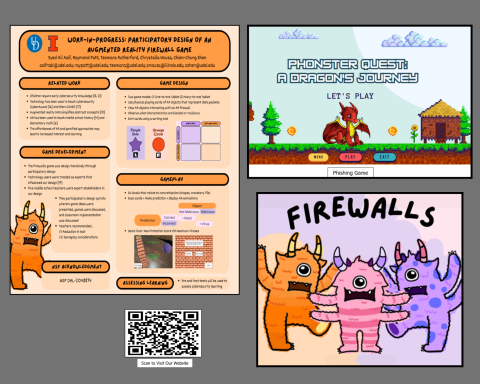Body
Image

Mixed Reality Based Interactive Cybersecurity Education for Middle School Students
Our project addresses the critical shortage of skilled cybersecurity professionals and the lack of diversity in the field, highlighted by a projected 31% increase in information security analyst roles from 2019 to 2029 (U.S. Bureau of Labor Statistics) and a tripling in the demand for cybersecurity roles since 2013 (Burning Glass). We aim to spark interest in cybersecurity careers through mixed-reality (MR) learning activities for middle school students, focusing on foundational cybersecurity concepts. Our interdisciplinary team from the University of Delaware collaborates with local schools and the state chapter of the Computer Science Teachers Association. We're developing MR modules on topics like steganography, phishing, and firewalls, refined through an iterative design process and classroom implementation in a pre/post-test study format. Significant progress includes the development of an augmented reality (AR) game about firewalls and a storyboard for a phishing game, informed by teacher feedback. A hackathon involving 17 undergraduate CS students created prototypes, integrating technology and educational design. This project aligns with the National Science Foundation's mission by promoting STEM education and aiming to expand the cybersecurity workforce, particularly among underrepresented groups. Through these innovative educational tools, we aspire to cultivate a diverse new generation of cybersecurity professionals.
Pillar 1: Innovative Use of Technologies in Learning and Teaching
The project innovatively employs mixed-reality (MR) and augmented reality (AR) technologies to teach cybersecurity to middle school students. We develop engaging, interactive MR activities on topics like firewalls, phishing, and steganography. These tools are designed to enhance learning through immersive experiences, making complex subjects accessible and exciting. Our AR game prototypes, developed through hackathons, further demonstrate practical applications of emerging technologies in educational settings.
Pillar 2: Partnerships for Career and Workforce Preparation.
The project collaborates with the University of Delaware, local schools, and the state chapter of the Computer Science Teachers Association. This partnership fosters direct engagement with educational stakeholders to tailor MR and AR learning tools for early career exploration in cybersecurity. We also integrate feedback from educators and students in the design process, ensuring our outputs align closely with real-world workforce requirements and enhance career readiness in STEM fields.
Pillar 3: Strategies for Equity in STEM Education
Our project enhances equity in STEM by integrating teacher insights into the development of MR and AR tools, ensuring relevance for a diverse student base. By enabling group play on single tablets, we improve access in under-resourced classrooms. Our games feature varied conceptual representations to cater to different learning styles and interests, making cybersecurity education accessible and engaging for all students, thereby encouraging a wider array of young learners to explore STEM careers.

Discipline(s)
Computer and informational technology science
Target Gradespan(s)
Middle school (6-8)
Category
Exploring Theory and Design Principles (ETD)